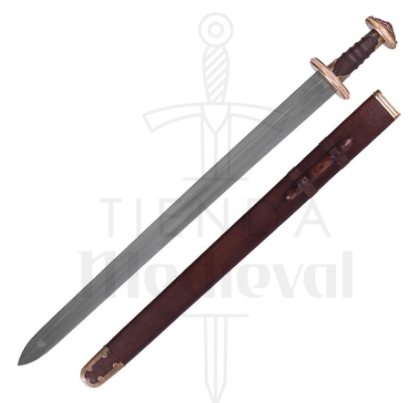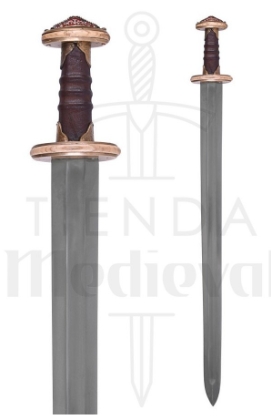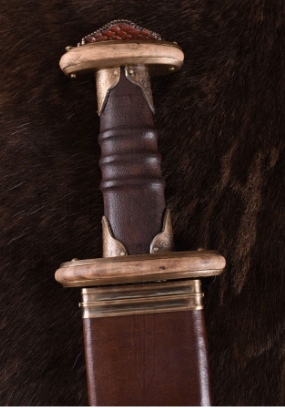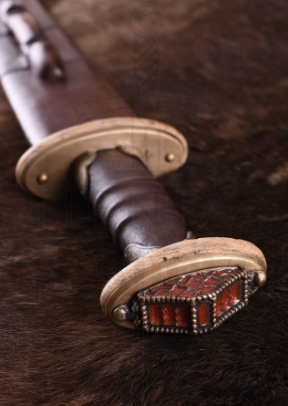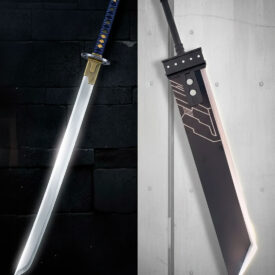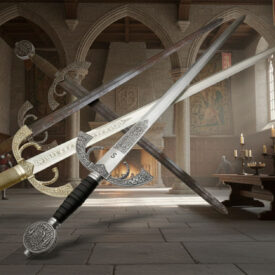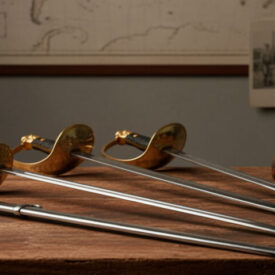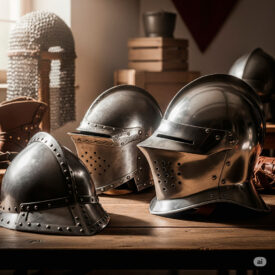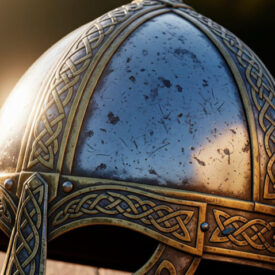Legend has it that, beneath a burial mound in Suffolk, a sleeping blade guarded the echo of a reign for centuries. When the mound was opened in 1939, not just corroded iron appeared: a history carved in gold and garnets emerged, the history of the Sutton Hoo swords.
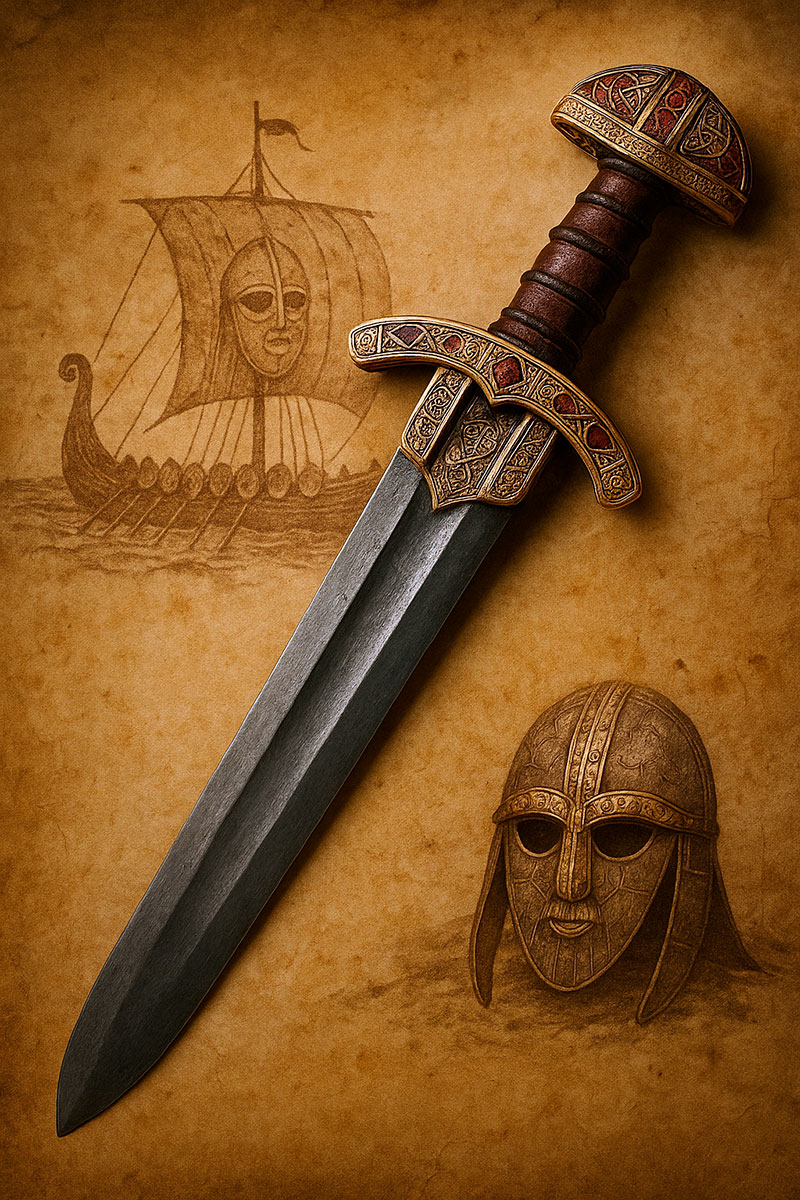
Why the Sutton Hoo sword continues to fascinate
The Sutton Hoo sword is not merely a weapon; it is a palpable symbol of Anglo-Saxon power, an artifact that unites engineering, commerce, and ritual. From its pattern-welded blade to its garnet-inlaid pommel, every detail speaks of expert hands and trade networks that reached far beyond the British shores.
In this article, you will discover how these swords were forged, what they tell us about the society that produced them, why the arrangement of the find suggests its owner was left-handed, and how modern conservation and replicas keep its legacy alive.
Chronology of the Sutton Hoo sword and the tradition of Germanic swords
| Date / Period | Event |
|---|---|
| Late Roman period – 5th century – early 7th century | Beginning of the tradition of Germanic swords, adopting and adapting the Roman cavalry spatha; finds in swamps such as Nydam, Kragehul, Vimose, and Illerup Ådal. |
| Continuous (5th – 7th century) | Sustained use of the sword blade’s shape and type with improvements in decoration. |
| c. 570 – 630 CE | The Sutton Hoo site is used as a cemetery for burials of high-status individuals. |
| c. 599 – 624 CE | Reign of Raedwald, King of East Anglia and Bretwalda; main candidate for the burial in Mound 1. |
| c. 600 – 650 CE | The 27 m funerary ship, similar in design to a longship, is dragged and buried in the great Mound 1 at Sutton Hoo. |
| c. 616 – 627 CE (prob. 625/6) | Probable date of Raedwald’s death, candidate for the burial in Mound 1. |
| c. 620 CE | Estimated date of the Sutton Hoo ship burial (Mound 1). |
| c. 625 – 630 CE | Dating of the Mound 1 burial based on 37 Merovingian coins minted after 595 and probably before 640 CE. |
| 6th – 7th centuries | Decorative peak of Germanic swords: gold and gem-inlaid hilts, highly decorated scabbards; the Sutton Hoo hilt (garnets set in gold) is a key example. |
| 1938 | First excavation at Sutton Hoo uncovers another ship burial (possible Mound 2), but the objects had been previously looted. |
| May 1939 | Basil Brown begins the second season of excavations at Sutton Hoo at the request of Edith Pretty; Mound 1 is opened and the silhouette of the 27 m ship and a treasure, including the Sutton Hoo sword, are discovered; the artifacts are moved to a safe place before the outbreak of World War II. |
| 1942 | Edith Pretty dies. |
| 1943 | A B-17 bomber crashes near Sutton Hoo (event later fictionalized in the film “The Dig”). |
| 1967 | Soil samples taken during excavations at the British Museum confirm the original presence of a body in the burial chamber of Mound 1, decomposed by acidic conditions. |
| 1979 | New excavations find iron nails indicative of a coffin in Mound 1; chemical analysis of the soil reveals phosphates, indicating body decomposition. |
| 1981 | Robert Engstrom commissions a replica of a Viking-style sword for Professor Robert Eldred. |
| 1985 | Eldred’s sword is exhibited at the International Congress on Medieval Studies in Kalamazoo. |
| May 19, 1989 | Sir David Wilson, director of the British Museum, thanks Scott M. Lankton for the replica of the Sutton Hoo sword; an article detailing Lankton’s replication process is published. |
| January 16, 1990 | Cyril Stanley Smith writes to Scott M. Lankton praising his replica and his pattern-welding work, mentioning his book “A History of Metallography”. |
| 1992 | Patrick Bárta begins to professionally manufacture swords. |
| 2002 | The Sutton Hoo interpretation center is opened by Seamus Heaney. |
| 2018 | The exhibition “Anglo-Saxon Kingdoms: Art, Word, War” at the British Museum highlights the Sutton Hoo sword. |
| February 8, 2021 | Publication of the article “Sutton Hoo, the treasure that made the Dark Ages shine” coinciding with the premiere of the film “The Dig” on Netflix; the film dramatizes the 1939 discovery. |
| Present | The Sutton Hoo sword is exhibited in Room 41 of the British Museum; Patrick Bárta has created a detailed replica with cloisonné garnets and pattern welding; research and excavations continue at Sutton Hoo; conservators combat corrosion with controlled humidity showcases and 3D images; experimental archaeologists recreate pattern welding techniques, confirming the skill of Anglo-Saxon blacksmiths. |
The anatomy of the sword: blade, hilt, and pommel
Observe the sword as if it were a map: the blade is the route, the hilt the artisan’s tale, and the pommel the warrior’s personal seal. Together they tell a biography.
The blade of a Sutton Hoo sword features a wide section and double edge, designed for both cutting and breaking through in battle. The pattern welding technique gives the blade stripes and waves that, when polished, shone like scales. This aesthetic-functional combination ensured flexibility and resilience.
The hilt, generally made of covered and bound wood, was complemented by brass or gold fittings. But the real spectacle was the pommel: gold pieces with openwork containing carved garnets, pieces that came from afar and spoke of trade routes connecting England with the world.
Pattern welding: technique and myth
Pattern-welding is not simple craftsmanship; it is a dialogue between metal and blacksmith. Iron rods were twisted, stacked, and hammered until the piece was homogenized. Then, when filed and polished, patterns emerged that were not empty ornament: they indicated knowledge of the material and advanced thermal control.
Today, experimental recreation has shown that these blades were not only beautiful: they withstood shocks, held an edge, and were repairable in campaign. The hypnotic appearance of their waves fueled the imagination of medieval chroniclers and poets.
What does the funerary assemblage reveal?
The assemblage found at Sutton Hoo — the ship, the sword, the helmet, the belt plates — creates a portrait of authority. These pieces were not there by chance: they were public symbols, designed to narrate the deceased’s status and ensure their memory.
The rich assemblage suggests international contacts: garnets possibly from Sri Lanka or India, silver pieces and accessories with Germanic and Byzantine influences. Each element is a clue about the political, religious, and commercial networks of early 7th-century England.
The mystery of the left-hander
One of the most intimate findings was the wear pattern on the pommel. The flattened filigree on one side and preserved on the other indicates use consistent with a dominant left hand. If the sword was placed on the right side of the empty corpse, the hypothesis of the left-handed warrior gains strength.
This detail turns the sword into a personal portrait: not only the status but also the body and technique of its bearer are recorded in the metal. In combat, a left-hander caused confusion in the opponent; in the burial pit, it became a distinctive feature that lasted 1,400 years.
The 1939 excavation: urgency and preservation
The discovery took place in a summer fraught with political tensions. The team worked quickly because Europe in 1939 was heading towards war. Even so, they managed to recover and protect artifacts that today form the heart of British heritage.
The subsequent conservation work at the British Museum transformed these corroded fragments into legible testimonies. Techniques such as corrosion stabilization, microphotography, and 3D modeling have allowed the sword to be studied without subjecting it to invasive treatments.
Replicas and options for collectors
The fascination with Sutton Hoo led contemporary artisans to attempt to reproduce the piece with historical fidelity. Modern replicas aim to replicate measurements, hilts, and decorative details without intending to replace the original.
When observing replicas, you will notice that many are built with EN45 spring steel, blades around 4.5 mm thick, and overall lengths around 89 cm. Attention to the pommel and its brass and garnet decoration is crucial to achieve the visual presence that characterized Anglo-Saxon swords.
Below you will find an automated selection of products related to replicas and Viking swords for collectors and enthusiasts.
Comparison: original vs contemporary replicas
| Characteristic | Sutton Hoo Sword (original) | Typical modern replica |
|---|---|---|
| Blade material | Forged iron with pattern welding and period alloys | Spring steel (EN45) or modern carbon steel |
| Overall length | ~89 cm (estimated) | ~89 cm (faithful design) |
| Blade thickness | Variable, approx. 4–6 mm at the spine | ~4.5 mm (standard in replicas) |
| Hilt | Wood covered with gold and garnet fittings | Wood, leather, and brass fittings with enamel |
| Weight | Approx. 1.1–1.4 kg (without scabbard) | 1.0–1.5 kg depending on materials |
| Decoration | Cloisonné garnets, gold openwork, enamels | Imitation garnets, gilding, and enamels according to the manufacturer |
| Functionality | Combatant and symbolic | Mainly decorative or for props; some are functional |
Technical comparison between types of early medieval swords
- Spatha/post-Roman: Longer blade length, used by horsemen; influence on Germanic design.
- Burgundian/Anglo-Saxon sword: Wide blade, double edge, and decorated pommel; balance between cutting and thrusting.
- Viking sword (late): Evolution of Germanic forms, with different proportions and decorations.
Technical comparison table
| Type | Approximate length | Typical material | Main use |
|---|---|---|---|
| Adapted Roman Spatha | 80–100 cm | Iron/Early Steel | Cavalry and open combat |
| Anglo-Saxon Sword (Sutton Hoo) | ~89 cm | Iron with pattern-welding | Cutting, thrusting, and status symbol |
| Viking Sword | 85–95 cm | Forged steel | Combat and prestige |
Conservation and modern techniques for studying the sword
Metal buried for centuries arrives at laboratories fragile and fragmented. Current conservation seeks to stabilize without erasing history. Humidity control, showcases with regulated atmosphere, and 3D images are key tools.
Photogrammetry and 3D scanning allow the topography of the hilt and the wear of the pommel to be studied without touching it. This approach has been decisive in interpreting the wearer’s left-handedness and in designing faithful replicas.
The narrative behind the objects
The Sutton Hoo pieces don’t just speak of metal. They speak of identities in transition: kings who negotiated between pagan and emerging Christian beliefs, elites who consolidated power through luxurious objects, artisans who transformed raw materials from all over the world into local symbols of authority.
When you look at a reproduction or a photo of the sword, you are seeing the confluence of technique, aesthetics, and politics. That is the greatness that continues to fuel the fascination of scholars and collectors.
Voices from the past: what the blacksmith would tell
Imagine the blacksmith lighting his forge, watching the red-hot steel as neighbors bring stones, metals, and garnets. For him, the sword was both a tool and a work of art; a clear proof of skill visible in every wave of the blade.
For the comitatus — the lord’s court — the presentation of a sword was an act of legitimization. By being driven into a burial mound, the sword sealed the leader’s memory and offered a promise of continuity.
Visual tour and legacies in showcases
The original sword rests protected today, but its image is reproduced in museums, books, and replicas. Each exhibition adds a layer of interpretation: technical conservation, historical narrative, and a staging that seeks to convey the magnificence of the find.
For you, history lover, the Sutton Hoo sword is a window. Through replicas, forging experiments, and exhibitions, you can touch — even symbolically — the hand of that left-handed warrior who crossed his destiny with metal.
